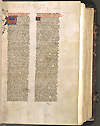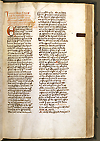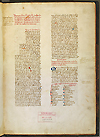The Spread of Translation
During the 13th and 14th centuries, inspired by the activity in southern Italy, scholars began seeking out more works throughout the Mediterranean world that had not been translated into Latin. In Spain and France, scholars poured over texts previously unknown in the West. As they found new Arabic writings, they often transliterated Arabic technical terms character by character, rather than translated them into their Latin equivalents. This introduced into Latin numerous terms understandable only to people with a sufficient knowledge of Arabic. Simon Januensis, an Italian lexicographer, botanist, and physician, compiled a dictionary of such terms, to provide readers with the proper Latin translation of transliterated Arabic words.
Toledo, Spain
Italian scholar Gerard of Cremona (ca. 1114–ca. 1187) traveled to Toledo, then at the border of the Christian and Muslim worlds. There, he learned Arabic and rendered into Latin major medical works that had not yet been translated.

Gerard of Cremona translated this large synthesis of medicine by the Persian scientist and polymath Ibn Sîna, known in the West as Avicenna.
Manuscript E 1, f. 1 recto.
Rome, Italy
Besides compiling a bilingual lexicon of Arabic technical terms transliterated into the Latin alphabet, Simon Januensis also worked in collaboration with Abraham ben Sem Tob, an interpreter of Arabic, at the court of Pope Boniface VIII (ca. 1235–1303), translating into Latin Arabic medical writings unknown in the West.

This work dealing with therapeutics is the 28th book of the large medical encyclopedia written by the Cordovan physician abu l-Qâsim, known in the West as Albucasis.
Manuscript E 33, f. 59 recto.

Known as Serapion, Ibn Sarabiyun was credited with the writing of a large treatise on materia medica. The original Arabic text seems to be lost. Only the Latin translation survives.
Manuscript E 40, f. 1 recto.
Last Reviewed: May 2, 2012


